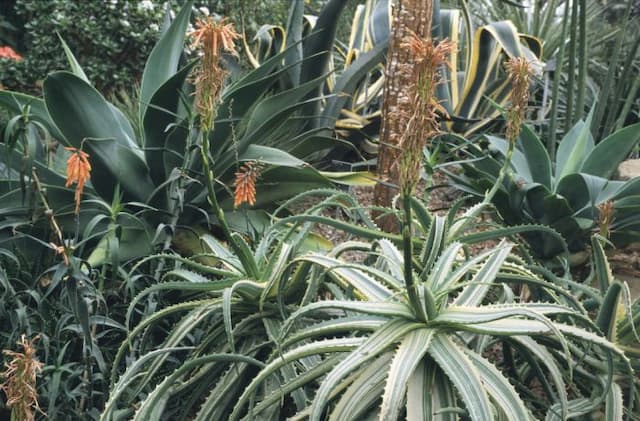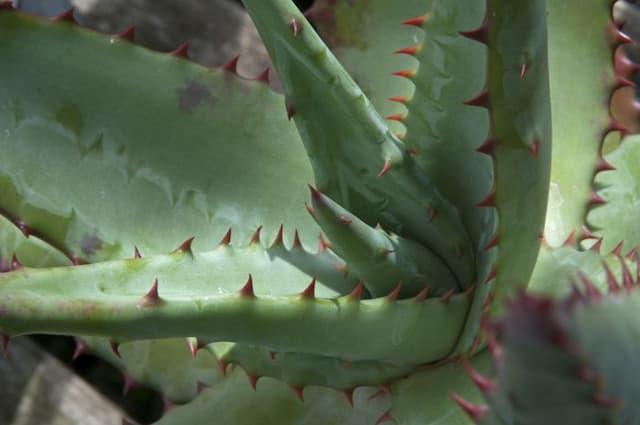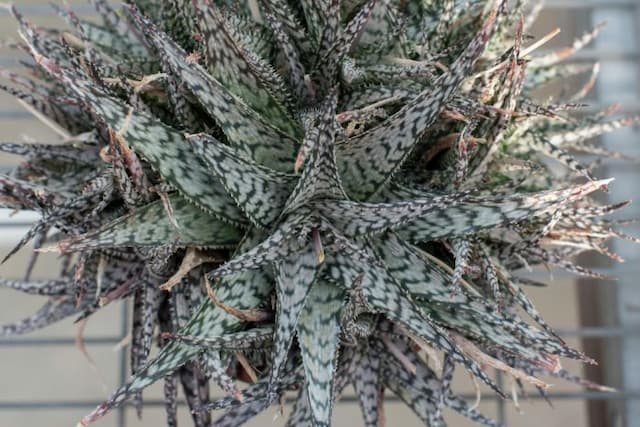Caulescent red-hot poker 'Coral Breakers' Kniphofia caulescens 'Coral Breakers'

ABOUT
'Coral Breakers' is an evergreen perennial to 60cm tall with grey-green, strap-like, arching foliage. Short, fat spikes of coral-red flowers fading to yellow are borne on stout stems in summer
About this plant
 Names
NamesFamily
Asphodelaceae
Synonyms
Red Hot Poker, Torch Lily, Poker Plant
Common names
Kniphofia caulescens 'Coral Breakers'.
 Characteristics
CharacteristicsLife cycle
Perennials
Foliage type
Evergreen
Color of leaves
Blue-green
Flower color
Orange
Height
3-4 feet (0.9-1.2 meters)
Spread
2 feet (0.6 meters)
Plant type
Herb
Hardiness zones
5
Native area
South Africa
Benefits
 General Benefits
General Benefits- Attracts pollinators: Kniphofia caulescens 'Coral Breakers', commonly known as Red Hot Poker, produces vibrant flowers that are attractive to bees, butterflies, and hummingbirds, enhancing pollination in the garden.
- Drought tolerance: Red Hot Poker is well-adapted to dry conditions, making it an excellent choice for water-wise landscapes and drought-resistant gardens.
- Low maintenance: It requires minimal upkeep once established, making it a convenient choice for gardeners of all skill levels.
- Long blooming period: The plant has a long flowering season which provides color and visual interest in the garden for an extended time.
- Architectural interest: With its tall flower spikes and grass-like foliage, it adds vertical interest and a unique texture to garden beds and borders.
- Deer resistant: Red Hot Poker is generally not preferred by deer, making it a good option for gardens in areas where deer browsing is a concern.
- Hardy perennial: It is a perennial plant that comes back every year, reducing the need to replant annually and providing consistency in the garden's design.
 Medical Properties
Medical PropertiesThis plant is not used for medical purposes.
 Air-purifying Qualities
Air-purifying QualitiesThis plant is not specifically known for air purifying qualities.
 Other Uses
Other Uses- Floral Art: Kniphofia caulescens 'Coral Breakers', also known as Red Hot Poker, can be used in floral art for its striking color and unique form, making the arrangement stand out.
- Garden Sculpture: The vertical and bold structure of Red Hot Poker can serve as a living sculpture in contemporary garden designs.
- Textile Dye: The flowers of the Red Hot Poker may be used as a natural source of dye for textiles, offering a range of warm hues.
- Photography Subjects: Red Hot Poker's vivid colors and distinct shape make it a popular subject for photographers, especially those focusing on macro and nature photography.
- Educational Tool: Botany students may study the Red Hot Poker for its unique pollination strategies and its adaptation to attract specific bird species.
- Bioindicator: In certain habitats, the presence of Red Hot Pokers can indicate the health of the ecosystem, especially in relation to pollinator populations.
- Nectar Source for Homemade Syrups: The nectar from Red Hot Poker flowers can be used to make homemade syrups for culinary purposes, adding a unique flavor to desserts and cocktails.
- Complementary Companion Planting: Red Hot Poker can be used in companion planting to create aesthetically pleasing and biologically beneficial plant communities within gardens.
- Seasonal Celebrations: Due to its bright, fiery appearance, Red Hot Poker plants can be incorporated into events and festivals as symbols of heat and energy, especially in the summer months.
- Element of Mystery in Children's Gardens: The exotic look of the Red Hot Poker can be used to create a sense of mystery and exploration in children's gardens or educational landscapes.
Interesting Facts
 Feng Shui
Feng ShuiThe Red Hot Poker is not used in Feng Shui practice.
 Zodiac Sign Compitability
Zodiac Sign CompitabilityThe Red Hot Poker is not used in astrology practice.
 Plant Symbolism
Plant Symbolism- Attention-Grabbing: The vibrant and fiery blooms of the Red Hot Poker symbolize being noticed or standing out in a crowd, much like their striking appearance in a garden.
- Strength & Endurance: This plant's sturdy nature and ability to thrive in tough conditions represent resilience and the capability to endure challenging situations.
- Playfulness: Its unique and almost whimsical flower spikes can symbolize a sense of fun and playfulness.
- Wealth and Prosperity: The lush, torch-like flowers may also be associated with wealth and prosperity, as their shape can resemble a flaming torch, often linked with abundance.
 Water
WaterRed hot pokers, including 'Coral Breakers', should be watered regularly with a deep soaking to ensure a well-established root system, especially during its first growing season. Once established, they are more drought-tolerant and require less frequent watering. Aim to water deeply once a week, providing about 1 to 1.5 gallons of water, which should suffice unless there are prolonged periods of drought or extreme heat. During particularly hot or dry weather, water twice a week to maintain soil moisture. Avoid overhead watering to reduce the risk of disease, and water early in the morning to allow any moisture on the foliage to dry before nightfall.
 Light
LightFor optimal growth, Red hot pokers require full sun conditions, meaning at least 6 hours of direct sunlight daily. Place 'Coral Breakers' in an area of the garden that is exposed to unfiltered sunlight for most of the day to encourage the best flower production. Avoid heavily shaded areas, as insufficient light can lead to poor blooming and weak growth.
 Temperature
TemperatureRed hot pokers thrive in a variety of temperature conditions but prefer a range between 50°F and 75°F. 'Coral Breakers' can tolerate temperatures as low as 20°F, making them suitable for growing in USDA hardiness zones 5 through 9. They can also withstand high temperatures well into the 90s, but consistent moisture should be maintained during extreme heat.
 Pruning
PruningPruning Red hot pokers involves removing spent flower spikes to encourage more blooms and maintain a neat appearance. 'Coral Breakers' should be deadheaded after the flowers fade, usually in late summer or early fall. Additionally, cut back the foliage to the base in late winter or early spring to make way for new growth. Pruning is not typically required more than once or twice a year since Red hot pokers are relatively low maintenance regarding pruning needs.
 Cleaning
CleaningAs needed
 Soil
SoilRed Hot Poker ('Coral Breakers') thrives in well-drained soil with a pH between 6.0 and 7.0. A mixture of loamy soil, compost, and sharp sand to improve drainage is ideal. The soil should be fertile and moderately rich in organic matter to support its growth.
 Repotting
RepottingRed Hot Pokers, like 'Coral Breakers', generally do not require frequent repotting and can be repotted every 3-5 years. They prefer to be left undisturbed as they establish clumps, so repot only when the plant outgrows its current space or the soil becomes exhausted.
 Humidity & Misting
Humidity & MistingRed Hot Poker ('Coral Breakers') tolerates a range of humidity conditions but prefers a drier climate. Keeping the humidity levels moderate, similar to typical outdoor conditions, is best. Excessive humidity can lead to fungal diseases.
 Suitable locations
Suitable locationsIndoor
Place in bright light, minimal water.
Outdoor
Full sun, well-drained soil, hardy.
Hardiness zone
5-9 USDA
 Life cycle
Life cycleKniphofia caulescens 'Coral Breakers', commonly known as Red Hot Poker, begins its life cycle as a seed that germinates in spring when temperatures are warm and the days are long. The seedling then develops into a rosette of narrow, arching leaves, from which a thick, central flowering stem grows. During late summer to fall, the flower spike emerges, displaying tubular flowers that transition from coral at the top to yellow at the base, attracting pollinators such as hummingbirds and bees. After pollination, the flowers produce seed capsules that mature and eventually release seeds to complete the reproductive cycle. In colder climates, the plant may go dormant in winter, with the foliage dying back and the plant conserving energy in its rhizome to survive until spring. With the return of favorable conditions, new growth resumes from the rhizome, beginning a new cycle of life for the Red Hot Poker.
 Propogation
PropogationPropogation time
Spring to Summer
The Red Hot Poker (Kniphofia caulescens 'Coral Breakers') is typically propagated by division, which is the most popular method for this perennial plant. The ideal time to propagate is in early spring or late fall when the plant is not in active growth. To propagate by division, gardeners should carefully dig up the clump of the plant and gently separate it into smaller sections, ensuring that each section has a portion of the root system and several shoots. These sections should then be replanted in well-drained soil and watered thoroughly. This method allows the plant to recover quickly and grow into a mature plant much faster than it would through seed propagation.









